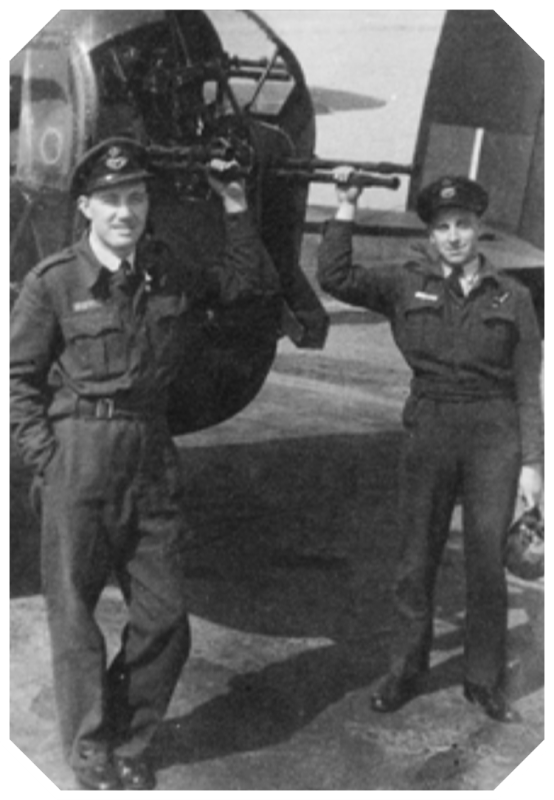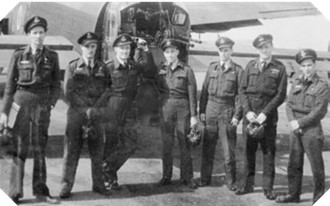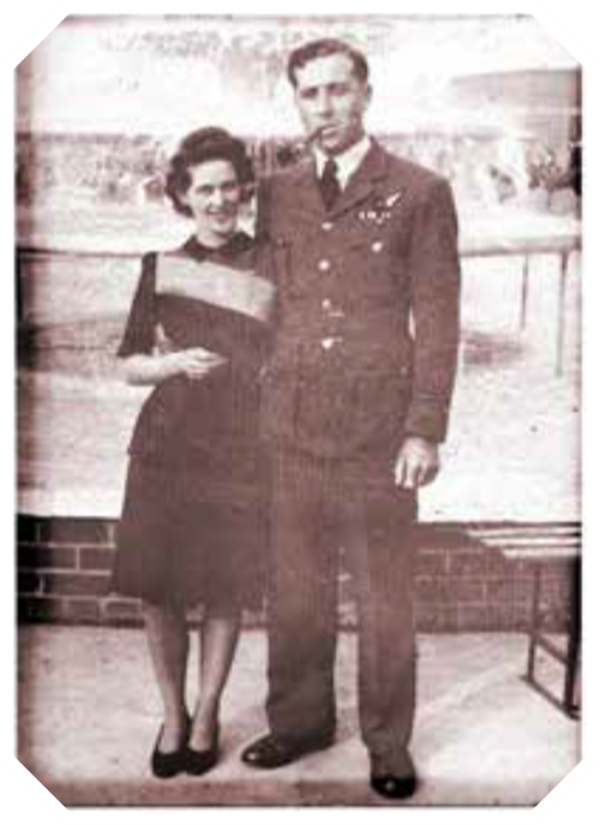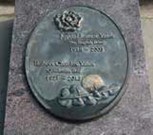Stories
Stories
A Very Lucky Man
Giving an ANZAC day speech at our local hall, my father, Bob Yates called himself a very lucky man. This is Bob’s story put together from his writings for the family, his logbook, taped recordings between him and fellow NZBCA member Harry Cammish, meetings with and notes supplied by Arthur Hollis DFC plus other sources as referred to.

Bob Yates (R) with fellow gunner Ron Kinsman, standing next to a Frazer Nash turret.
(Credit: Yates family)
The RAF Bomber Command air crew suffered the heaviest percentage losses of any of the western allies armed forces in WWII. Of the 125,000 who flew, 55,573 were killed, a staggering 44.4%. You needed a lot of luck to survive.
On 12th May 1943 50 Squadron Lancaster D-Dog left Skellingthorpe heading for Duisberg. Having crossed the enemy coast, they arrived at the concentration point and joined the orbiting Bomber mass. Unfortunately, a Halifax was orbiting in the wrong direction and met them almost head-on. The Lancaster lost six feet off its starboard wing and one of the Halifax’s laminated wooden propellers scythed through the Lancaster’s mid upper turret injuring the gunner, Flight Sergeant Robert (Bob) Charles Yates. His oxygen mask was shattered, and it took the medics many sessions over the next few days to remove bits of Bakelite and wood splinters from his face.
Fortunately, his goggles, though smashed, saved his eyes. Many bits were never removed, and his face had black pot marks for the rest of his life. Among Bobs souvenirs was part of the Halifax propeller that was wedged in his shattered turret. That’s how they knew it was a Halifax (only RAF bomber of the time with wooden propellers). The pilot, Flying Officer Arthur Hollis nursed the damaged Lancaster back to base, a feat he achieved many times.
Nothing is known of the fate of the Halifax.
But this was war time. The next day and in a new plane (A- Apple), it’s off to bomb the Skoda factory at Pilsen. Bob’s logbook is succinct: 5 Group only. Attack poorly concentrated. Starboard outer engine failed leaving target. A later note shows that 11% of the attacking force failed to return and that the Pathfinders had marked the wrong target.
The last raid for May was on 31st to Wuppertal. This time they had their seventh, yes seventh, new Lancaster for the month. Hollis had been promoted to Flight Lieutenant, and Bob was in the rear turret. According to Bomber Command War Dairies, Wuppertal was an outstanding success in the battle of the Ruhr, but Bob notes that 33 aircraft and crews were lost.
You had to be very lucky to survive in Bomber Commands aircrew and yet they were all volunteers: there by their own choice. Why? They could not have known the fate that awaited them. Well, there must have been many reasons.
In Bob’s case when WWII broke out, he was a painter and decorator as had been his father and grandfather before. His father Leonard had served with the Third Battalion of the Coldstream Guards in WWI and was twice wounded and twice went back to France to fight again. On the second occasion while convalescing in England he was attached to the Tower of London guards and was the bearer of the Towers famous Keys. In later years he would amuse his children and grandchildren by putting on a one-man re-enactment of The Keys Ceremony.
Leonard was a union leader and took part in the hunger marches in the 1920’s and 30’s. This resulted in many bosses refusing to employ him although he was a Master Painter. The family often had to resort to charity for food and other essentials. This fear of poverty and not being able to provide for his family haunted Bob all of his life. Leonard’s stories of the horrors of Paschendale and life in the trenches were enough to convince young Bob that immediately after Chamberlain announced that ‘a state of war existed between Britain and Germany’ he volunteered for the air force rather than wait to be called up and risk the army.
Having little formal education, Bob applied to become an air gunner but was turned down and became a ground gunner in what later became the RAF Regiment. Bob’s first posting was to Castle Bromwich to defend the airfield from which Fairy Battle Bombers and later Spitfires were test flown prior to delivery to front line squadrons. They were equipped with Austin and Standard car chassis fitted with a rudimentary lightweight armoured bodies and a Bren gun, so mounted as to be next to useless against low flying German aircraft.
It was here he got his first flight in Westland Lysander that had escaped the German invasion of France At every opportunity he reapplied for air gunner training, but the air force in 1940 had other priorities, such as home defense so Bob managed to get onto a motorcycle training course and joined a Barrage Balloon squadron based at Gosport, helping defend the Gosport, Portsmouth and Southampton docks. In theory they were a mobile unit that could travel between towns that intelligence predicted would be targeted. In practice it usually didn’t work, and they would arrive many hours after the raid ended.
As a dispatch rider keeping the various widely spread balloon sites in touch with each other and HQ, Bob was in the middle of the bombing. Often the roads would be blocked with fires and building debris. Downed power lines were a particular hazard for motorcyclists. On one occasion he was glad of his heavy leather riding gear when helping rescue a family from a burning house and was surprised by the amount of shrapnel that rained down from the ack-ack shells and yes there were bombs exploding all round. On one occasion a large one landed within a few metres but failed to explode. Thus, he literally learned about air raids from the ground up.
Finally in July 1942 he was invited to attend an aircrew selection panel in London and the next month posted to RAF Credenhill near Hereford for air gunner training. At midday on 21 November, he made his first flight with a camera gun mounted in the turret of a Bolton Paul Defiant and 50 minutes later fired 200 rounds of real bullets. One month later he was certified as a qualified Air Gunner.
On 6 February 1943 he started with1660 Conversion Unit at Swinderby flying Avro Manchester’s initially with S/Ldr Gardiner, but later he flew with F/O Arthur Hollis, a relationship that would last for the next six months and resume again 75 years later.
On 16 February they converted to the Avro Lancaster and on the 12 March commenced duties with 50 Squadron at Skellingthorpe near Lincoln. ten days later their first operational flight was to St Nazaire followed four nights later to Berlin. Over the following months they were to raid Essen, Kiel, Pilsen, Stettin, Duisberg, Dortmund, a floating dock off Copenhagen, Wuppertal, Friedrichshafen, Spezia, Gelsenkirchen, Cologne, Hamburg Turin, and Milan, some several times.
At the front of a Lancaster the pilot, navigator, flight engineer, radio operator and bombardier sat close together in a heated cabin, but no such luxury for the two gunners sitting alone down the middle and back of the aircraft. The rear gunner in particular had a hard time as a panel between the guns was removed for better vision, but meant he was exposed to temperatures well below freezing. Also, the rear gunner had the most dangerous position of all as most fighter attacks came from the rear.
Many a rear gunner’s remains were literally hosed out of his turret. Jock Walker was the usual rear gunner and Bob the mid-upper, but they sometimes swapped around. A successful bomber crew were a well drilled team whose survival depended upon each other’s skills and the trust. When making the final bombing run the bomb aimer controls the aircraft and during fighter attacks it’s usually the gunners’ yelling instructions to the pilot.
On the night of 20 June 1943, 50 squadron left their home base at Skellingthorpe in Lincolnshire to take part in what was known as a shuttle raid. The first target was the German Industrial city of Friedrichshafen home of the Dornier aircraft company, the great Zeppelin works, the engine, car, and tank manufacturer Maybach, ZF who are still today one of the world’s largest transmission manufactures, it was also the base for production of the V2 rocket.
Having bombed Friedrichshafen, they flew on to Blida in North Africa to rest, refuel and re-arm before attacking the Italian naval base at Spezia on the 23rd. The airfield at Blida was next to a POW camp housing some the remnants of Rommel’s Africa Corp. In the evening, they listened to the Germans singing a lilting song over and over again Although they did not understand the words the tune stuck and both Jock and Bob had been choir boys so quickly learnt to hum and whistle it.
They visited Algiers, where they purchased crates of oranges and Algerian wine. These were carefully loaded into the Lancaster and having done their bit in bringing down Benito Mussolini, they headed back to Skellingthorpe via the Alps.
In theory, over the Alps they should have been safe from German night fighters, but the Germans had the same idea and flew regular patrols through Swiss air space. Flying over the Alps meant flying through cloud, which on the night of 23rd was 10/10th. In those days, night flying over high mountains in cloud was a nerve-racking experience. Bobs in the mid-upper turret and Jocks in the rear, but in such conditions, everyone is keeping a lookout. Suddenly behind and above them there was a flash of light.
Was it a German fighter or another Lancaster on its way home? In those circumstances you don’t give away your own position by opening fire and without positive ID. It could be a friend. Wait and see.
A few minutes later another flash, but again no ID, but as the flash was in the same position as the first it was a worry as the German fighters had radar and they could be stalking them, just waiting for a break in the clouds to close in and shoot visually. After a couple more sightings the crew had a discussion and came to the concussions, firstly that the chances of one of their own aircraft following on exactly the same course and speed as them was practically nil. Secondly that it was a German fighter stalking them on radar, not being completely sure where the Lancaster was. Best to stay hidden and hope he gives up or runs out of fuel.
Time passes, a few more flashes, nerves at breaking point. Then Hollis the skipper warns them. The clouds are thinning, and they could be exposed at any time. Next flash, open fire.
Seconds later six Browning Machine guns start pumping 6900 rounds per minute of tracer and armour piercing bullets at the flash. No return fire but the flash disappears, only to reappear 30 seconds later. Again, the two gunners let fly and again the flash disappears. This pattern is repeated several more times until the Lancaster finally breaks free of the cloud… and despite the thousands of rounds fired at it … the moon is still shinning up there to this day.
If you go to the Settlers Cemetery at Hobsonville you can see the moment captured in 3D on a bronze plaque on Bobs grave. The moon and the Lancaster emerging from the clouds.
Lancaster and the moon emerging from the clouds. Recorded in bronze at the Hobsonville Settlers Cemetery.
(Credit: Yates family).
But back in 1943 there were to be other repercussions. Having successfully returned from the shuttle raids they were given a few days off to visit family and friends. On their respective ways home Jock and Bob met at Nottingham Central railway station while waiting for a train back to Lincoln. They sat on their luggage and began to hum and whistle the German tune. Didn’t take long before they became aware that a group of men in raincoats and trilby hats had surrounded them, shortly followed by an MP Officer and six men. They were arrested as Spies and taken to the local MP cells.
Hans Leip’s Lily Marleen (Marlane in English) had yet to become the universal solders song, so anyone who knew it had to be German, according to the SIS. After a night in the cells, they were allowed to telephone their flight commander who vouched for them and explained how they came to know the tune. Only then did they find out its name from the SIS. The flight commander got the squadron commander involved and he demanded that, as he needed them for a raid that night, the MPs must provide road transport immediately.
A couple of hours later an MP car deposited them back at Skellingthorpe, where they were duly arrested for being AWOL and marched before the squadron commander who sentenced them to a round of drinks in the Sergeants Mess.
On 25 July, they were coned by the search lights over Essen. Hollis threw the Lancaster all over the sky for four minutes, before finally escaping, but a night fighter had latched onto them and inflicted major damage. One shell exploded between the rear and mid upper turrets, wounding both gunners and other shells wounded two other crew members up front, as well as destroying many controls, both rudders, the ailerons and undercarriage. Yet again Hollis got them back to the UK where they crash landed at Wittering.
Bob and the two wounded front cabin crew (names not recorded) were patched up at a local hospital and flown back to Skellingthorpe the next day in a couple of Lysander’s. Jock was too badly injured so remained in a local hospital and was never seen again by the rest of the crew.
Luck played a major part in bomber crews lives and Hollis and his crew were posted to 617 squadron (un-officially known as the Suicide Squadron now immortalised as the Dam Busters). However, no crew in 50 squadron had ever completed an operational tour and with morale low due to losses, the postings were deferred to allow them to complete their tour. Four days later with a new rear gunner and yet another new Lancaster they bombed Hamburg and Bob was able to claim his fourth kill, a Ju 88 with 180 rounds. Bob’s logbook entry ends ‘a good prang’.
On the 16 August 1943 Arthur Hollis and his crew completed their first tour. According to Harry Cammish a big celebration was held to mark this milestone in 50 Squadron history. Hollis had been awarded the DFC, as also had navigator Dick Palmer and bombardier Ted Kemp. Wireless operator Tom Cheshire the DFM and engineer Tom Adshead and air gunner Bob Yates were both mentioned in Dispatches. Only poor old Jock Walker, the rear gunner, missed out.
Officially the crew were now entitled to a period of leave before taking up their postings to 617 squadron, but Bobs luck held again. With Bomber Command expanding rapidly the postings were cancelled and all sent on courses to become instructors. All that was except Jock who was still in hospital when the rest of the crew made their last four trips. Thus, he had not completed his tour and, his posting to 617 was never cancelled. When fit for flying again the posting took effect. It seems he took part in at least two raids with 617 but was killed probably during the attack on the Saumur rail tunnel.
After 2 weeks’ leave Bob took up duties at 1660 conversion unit at Winthorpe. Although relatively safe these were not the happiest of times as Bob suffered chronic air sickness unless on operational flights. The tensions and concentration of ops left no time for sickness. At the start of 1944 he transferred to the Air Armament School at Manby and passed out from there as a qualified Instructor in February now with the rank of Pilot Officer.
The school used Bristol Blenheim Mk4. He then had four months as an instructor with 1661 conversion unit at Winthorpe flying in the unloved Stirling’s. In August he was posted to Central Gunnery School at Catfoss to qualify as a Gunnery Leader. Here they flew Wellington Mk3 in mock combat with Mustangs, Spitfires, Thunderbolts, Marauders, Hurricanes and Martinets.
In November, now promoted to Flying Officer, he returned to 1661 Conversion Unit as a senior instructor. His logbook for 11 Nov notes that during fighter affiliation the pilot corkscrewed the Stirling to violently and lost control. The aircraft turned onto its back, and they lost 6000ft before the pilot regained control. A reminder that the air force suffered heavy losses during training as well as during ops. It wasn’t until 1945 that Lancaster’s finally replaced the Stirling’s.
Bob completed his first non- operational tour on 10 April 1945 and 4 days later Flight Lieutenant Yates returned to operational duty as gunnery leader of 467 Squadron RAAF at Waddington. By now the bombing war had changed from strategic to tactical to help the advancing Allied armies. Over the next 10 days they raided the rail marshalling yards at Pilsen and Komotau and the oil refinery at Tonsberg in Norway. Twice fog prevented them from returning to Waddington, so they diverted to Boscombe Down and Lyneham. Tonsberg was their last night operation of the war as on the 2nd May they took part in a daylight raid and on 4 May switched to ferrying released POW from Juvincourt and again on 8 May the day of Germany’s surrender.

All officer crew 467 Sqn RAAF, Bob is in the centre.
(Credit: Yates family)
With the war in Europe at an end 467 squadron returned to Australia and Bob was transferred to 106 squadron at Metheringham who were being prepared for Tiger Force, the name given to British forces intended for use in the invasion of Japan. Until they could get enough Lincolns, Lancasters were being ‘tropicalised and fitted with long rang fuel tanks.
Bobs luck held again when following the second A-bomb the Japanese at last accepted the inevitable and surrendered so Tiger Force was not needed and the slaughter of millions of both Japanese and Allied personnel avoided.
In September they made two trips to Bari in Italy to repatriate 8th Army personnel. Bob stayed with 106 until the start of 1946 when he re-trained as a supply officer. In 1948 the RAF Volunteer Reserve was being wound down and Bob went for a Burton, in more ways than the usual RAF slang. The Air Force put him through a business management course, and he got a job as the manager of Burtons Mansfield store.
After a series of disagreements with the area manager he left in 1950 and joined the bearing manufacturer Ransome and Marles in Newark, becoming an instrument technician. At this time, the communist funded and lead unions were starting to destroy British Industry and over the next few years Bob, having had his appetite for Australia whetted by 467 squadron decided to emigrate. He applied to the RAAF, RCAF and RNZAF and the first to invite him for an interview was the RNZAF.
By the time, the other two also invited him for an interview he had already been accepted by RNZAF where he stayed for the next 21 years, until being plucked by Textron to be the Supply Manager for their newly established Bell Helicopters New Zealand. Bob loved flying in Choppers (no air sickness and close to the ground so that you can see the scenery) so despite being back in his dreaded Civvy Street he thoroughly enjoyed his last 5 years’ work before retirement, in 1980.
At this point we’ll fast forward to 2008 when one of Bob’s grandsons, at that time a Heathrow based Boeing pilot, saw an article on a speech given by Arthur Hollis at a 50 Squadron reunion dinner. Garrick contacted Arthur who invited him to his large but decaying country house on 5 acres of land compete with lawns, flower beds, a walled garden, glass house, a lake with jetty and row boats, three Oast houses (hop drying) and large implement sheds, in the Kent village of Westwell. If you look it up on Google earth it’s the large house next to the church. Arthur and Garrick became friends and on subsequent visits they studied the differences between Bobs and Arthurs logbooks and flying Lancaster’s compared with B757’s.
Comparing the logbooks it would be easy to believe that they flew on different raids. Looking backwards and upwards was very different from looking forward and downwards. This got a correspondence going between Bob and Arthur until they were both too old and ill.
Among other points to arise was that while Bob was training for Tiger Force, Arthur was already in Hong Kong planning for the arrival of the Squadrons. When my wife and I visited the UK in 2010 Arthur invited us to visit him and Garrick drove us down. Arthur greeted us at the door, monocle in place, and enquired if we drank Champagne. This set the scene for a most pleasant day and many old stories were re-visited plus a few new ones.
One that Arthur told against himself was at a dance on their rare nights off the crew used to take a bus into the Lincoln dances. As the dance started, the girls would congregate at one end of the hall and the airmen at the other. Now Bob, often referred to as ‘gentleman Bob’ was a charmer and had a way with the ladies so it was always his job to go over to the girls and invite them over to the crew’s table.
On this particular night Arthur spotted an outstandingly beautiful girl and uttered the words ‘Cor she’s a smasher. Bob brings her over’ Bob’s reply caused hilarity among the rest of the crew. ‘Hollis, we didn’t know you were human!’ Bob dutifully brought ‘the smasher’ and her friends to join the crew and a few months later married her.

Bob and Joy Yates, while on leave, 1944.
(Credit: Yates family)
Bob and Joy had 3 sons, 2 granddaughters and 6 grandsons.
Bob Yeates and Arthur Hollis died within a few weeks of each in 2013 both in their mid-90s. Two very lucky men.
Robin Yates – 2018
